NEET physics
Sponsor Area
If force (F), velocity (v) and time (T) are taken as fundamental units, then the dimensions of mass are
-
[FvT-1]
-
[FvT-2]
-
[Fv-1T-1]
-
[Fv-1T]
D.
[Fv-1T]
We know that,
F = ma
That is,
F = mv/t
So, 
Sponsor Area
A projectile is fired from the surface of the earth with a velocity of 5 m/s and angle  with the horizontal. Another projectile fired from another planet with a velocity of 3 m/s at the same angle follows a trajectory which is identical with the trajectory of the projectile fired from the earth. The value of the acceleration due to gravity on the planet is,
with the horizontal. Another projectile fired from another planet with a velocity of 3 m/s at the same angle follows a trajectory which is identical with the trajectory of the projectile fired from the earth. The value of the acceleration due to gravity on the planet is,
-
3.5
-
5.9
-
16.3
-
110.8
A.
3.5
If the trajectory is same for both the projectiles, their maximum height will be the same.
That is,
(Hmax)1 = (Hmax)2
i.e., 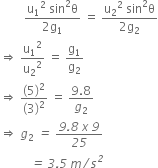
A particle is moving such that its position coordinates (x,y) are (2m, 3m) at time t = 0, (6m, 7m) at time t = 2 sec and (13 m, 14m) at time t= 5 sec. Average velocity vector (vav) from t = 0 to t = 5 s is,
D.

Average velocity vector,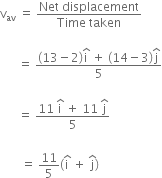
A system consists of three masses m1, m2 and m3 connected by a string passing over a pulley P. The mass m1 hangs freely and m2 and m3 are on a rough horizontal table (the coefficient of friction=  ). the pulley is frictionless and of negligible mass. The downward acceleration of mass m1 is,
). the pulley is frictionless and of negligible mass. The downward acceleration of mass m1 is,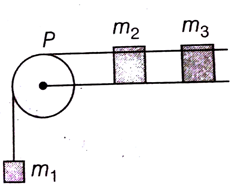
C.

First of all consider the forces on the blocks,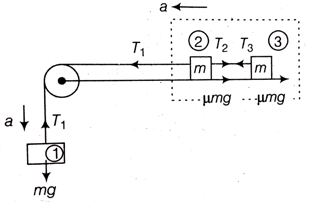
For the 1st block,
mg - T1 = m x a ... (i)
Let us consider second and third block as a system,
Then,
T1 -  = 2m x a
= 2m x a
mg ( ) = 3m x a
) = 3m x a
The force F acting on a particle of mass m is indicated by the force-time graph as shown below. The climate change in momentum of the particle over the time interval from zero to 8 s is,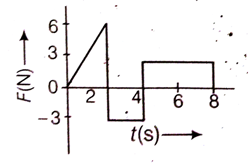
-
24 Ns
-
20 Ns
-
12 Ns
-
6 Ns
C.
12 Ns
The area under F-t graph gives change in momentum.
For 0 to 2 s,
For 2 to 4 sec,
For 4 to 8 sec,
So, total change in momentum for 0 to 8 sec is,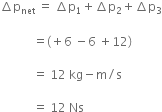
Sponsor Area
Mock Test Series
Mock Test Series











